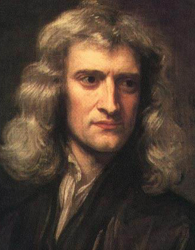Physicist and mathematician Isaac Newton was one of the most influential figures of the scientific revolution. He made significant contributions to calculus and his theories on motion and gravitational forces laid the foundation for modern physics.
Sir Isaac Newton’s Early Days
Although his birth was recorded as occurring on Christmas Day, an adjustment to the new calendar in the 17th century makes his birthday January 4, 1643. Newton’s father died before his birth, and his mother remarried a wealthy man a few years later. She left Newton with his grandmother in Woolsthorpe, England and moved to a neighboring town, where she raised three children with her new husband. When his mother was widowed again she sought her eldest son’s help to manage the estate she had inherited.
Newtown was inept in land affairs, however, and returned to school, ultimately earning a full scholarship to Trinity College, Cambridge. After four years there, a plague epidemic forced him to return home. While studying outside of school he first began focusing on gravitation and optics.
Sources in this Story
- Biography.com: Sir Isaac Newton Biography
- University of Virginia: Galileo and Einstein Lecture Notes by Michael Fowler: Isaac Newton
- Science Channel: Newton’s Laws of Motion Interactive
- Isaac Newton Institute for Mathematical Sciences (Microsoft Encarta): Isaac Newton’s Life
- Rutgers University: History of Algebra Seminar: The Newton/Leibniz Conflict in Context
- MacTutor History of Mathematics Archive: Lucasian Chair
- BBC Historic Figures: Isaac Newton
Notable Accomplishments
The first of Newton’s discoveries that he shared with the public was the reflecting telescope, which used a mirror to sharpen the image. Newton had developed various scientific and mathematical theories, but was hesitant to publish his work; insecurity about the quality of his writing would plague Newton throughout his career.
Newton’s classic, three-volume work, “Philosophiae Naturalis Principia Mathematica” (“Mathematical Principles of Natural Philosophy”) was published in 1687, and contained some of his most famous contributions to physics. The Principia included several important calculations of gravitational forces, and also included his three laws of motion.
Newton introduced the idea that white light comprised many different colors. The theory was widely challenged, and Newton delayed publishing his work out of fear of criticism. “Opticks” did not appear until 1704, when many of his critics were dead.
Along with Gottfried Wilhelm Leibniz, Newton is credited with developing calculus. The two mathematicians and their disciples spent years in a heated dispute about who had invented it.
Newton also studied alchemy, chemistry, theology and philosophy and spent several years as a professor at Cambridge. The second (and most famous) holder of the Lucasian Chair for Mathematics, he was also twice elected MP for Cambridge University.
The Rest of the Story
Newton continued to publish and work in the Royal Society until his death on March 31, 1727. Most of his work in later years involved reworking his previous publications. Even without producing new material, he bolstered the credibility of his previous work.
Although subsequent discoveries in the 19th and 20th centuries superseded various aspects of Newton’s theories in physics, he enjoyed prominence in the field for more than a hundred years, and many of his contributions continue to be studied and highly valued today.
This article was originally written by Rachel Balik; it was updated January 4, 2018.











